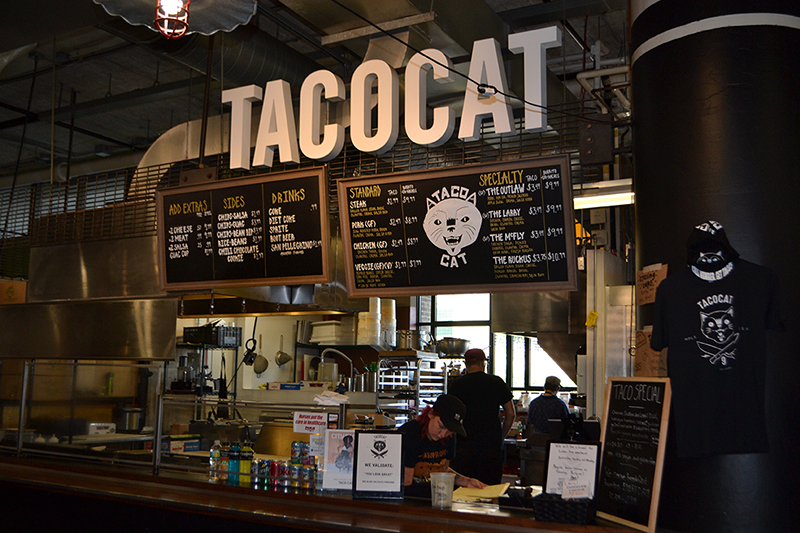By Nancy Weingartner
For three and five years, respectively, Tristan Jimerson and Daniel Laeger-Hagemeister delivered sandwiches freakishly fast for Jimmy John’s. No one, Jimerson says, has delivery as dialed in as Jimmy John’s. Since the delivery zone for each store is small, their sandwiches sometimes rode in cars, sometimes in messenger bags via bicycles.
“Jimmy John’s was our training,” he says.
The two have taken that knowledge and passed it on to a fleet of former bike couriers who as victims of the shrinking demand for couriered legal work thanks to the Internet are now peddling food. Rather than compete with the sandwiches and pizzas of the world, however, the pair delivers tacos and burritos out of their storefront space, Taco Cat, in the Midtown Global Market in Minneapolis—rain or shine, snow or heat.
Bike delivery is not for the faint of legs. Taco Cat’s bikers pedal around 40 miles per shift. “The courier business is a young person’s game,” he says, adding most of their riders are in their mid-20s to early 30s. The pay ranges from $16 an hour (including tips) to $28 on a good night. Couriers provide their own bikes (most average six), their own helmets, custom messenger backpack, safety lights and are responsible for their own bike maintenance, Jimerson says. Part of the job interview includes changing a tire quickly.
And yet, they have people willing to move here—from places like Chicago and Toronto—for the job.
The reason’s not hard to fathom. The hours are flexible, the benefits good and nothing beats time in the saddle. Most are professional or amateur racers, he says. Currently, he employs around 16 full- and part-time riders on staff.
Leigh Antonett, 24, just happened to be locking her bike onto the railing of the market on the day I was interviewing Jimerson. It was fortuitous in a number of ways, but especially because Jimerson explained that he and his partner have started declining photo ops. “We’re white guys making tacos,” he says. “We’re culturally sensitive.”
Antonett has a degree in cross-cultural studies, but “I really like this,” she says about her delivery job. Since all of Taco Cat’s delivery bikers are cross-trained, she also works two shifts a week in the kitchen doing prep. She needs freedom from sitting at a desk all day, plus she never has to hit the gym after work.
Taco Cat doesn’t require uniforms or logos on the bags. When asked why, Jimerson pushes his oversized frames back up his nose and muses, “How can I say this?” Basically, in order to make time, bike deliverers often take liberties with the traffic laws, and no business wants its logo darting in and out of traffic in a nonconformist kind of way.
Jimerson and Laeger-Hagemeister originally started delivering tacos out of one of their apartments one day a week and it took off. The original fan base was good food for drunk people, he says. Because of the inevitable health department’s visit, the two took their tacos to a shared kitchen at Midtown Global Market. When a permanent spot opened up, they applied for it and were selected. The menu is chef-designed and while they try to keep expectations low in order to succeed expectations, their food has won awards.
The key to delivery is to pack tacos tight to keep them warm and together. Burritos are rolled in multiple layers of foil and salsa is sent in its own container. Bikers have multiple deliveries; three is ideal, but they sometimes have as many as six (nine is the all-time high). Delivery people pack their own orders and if the order is wrong, they make a return bike ride with the missing items with little hope of a second tip.
The location on Lake Street is ideal. The ethnic market serves as the food court for a nearby hospital and Taco Cat has partnered with four breweries in its delivery area. “We’re an alternative to a food truck,” Jimerson says. And in one case, they’re an add-on.
While Jimerson isn’t adverse to opening a second location, it will only happen when they have the cash to do so. Neither partner is looking to give up any control. And even though he’s only 29, Jimerson has a curmudgeon’s view of the industry he loves. His advice to anyone wanting to get into the restaurant business is: “Be young enough so that your body can take 60 hours a week of hard labor, be able to live on $19,000 a year and give up any social interaction (away from the restaurant).”
But for him, working with kitchen people is more fun than office people. “You see a slice of the world in kitchens,” he says.
Once the interview was over, he returned to the kitchen to cook, donning a maroon baseball cap, which proved his point. In white letters across the crown it said: “Tired.”


